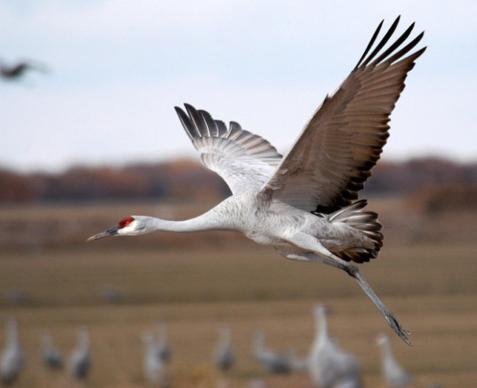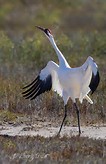Something’s fishy. Is it fate? Chance? God?
On the Platte River in central Nebraska I gather with friends from Chicago for the spring migration of the Sandhill Cranes. We arrive at our rented cabin just in time for the dusk fly-in ¼ mile down the road at the Audubon Rowe Viewing Stand on Elm Island Road. On the boardwalk-like stands we parrot the 100-plus birdwatchers as they steer their binoculars toward the goose-like honking in the sky. The bugling cries grow louder as the cranes start to
appear. Thousands of birds swirl in the overhead vortex down into the shallow river with their spindly feet splayed like landing gear on an airplane. It takes about two hours for the birds to land in their overnight roosts on the sandy Platte. We press our binoculars into our eye sockets until the very last bird nudges itself into place, snuggling alongside its friends in the water for the night.

The long-beaked crimson-headed North American Sandhill Crane coexisted with dinosaurs, making it one of the world’s oldest bird species. For six weeks every spring, 600,000 of these five-foot tall grey beauties stop in Central Nebraska.
At dawn, Peter, Amy, Anne, Laurie and I make our way back to the riverbank for the lift-off. The cranes yak each other awake in one of nature’s most melodic cacophonies. They fly off in waves after socializing for a long stretch extending their time on the river to mid-morning. During the day they forage in the corn fields adjacent to our cabin, packing in calories for their long trip north.
Murmuring overtakes the viewing stand. The nature-loving brood from Illinois, California, New Jersey and Florida grow collectively quiet to hear the cranes’ every cackle, trill and honk. Conversations spring up, “I was in New Jersey once. Drove out route 80 to 70 to 35 to the Atlantic Ocean.” Why do men always talk in numbered roads?
I overhear an Audubon tour guide whisper on down the line to her group, “right there, below that white roof at the river’s bend, there’s a whooping crane.” I focus my binoculars. There it is.

There are 500 whooping cranes in the wild in North America. And I just saw one.
I run to my pals at water’s edge repressing a squeal, “There’s a whooping crane!” We are silenced by the stark white ladle-shaped body of the whooper shuffling among the blue-grey hoards of Sandhills over a mile upriver. We report the news to strangers around us, lending our binoculars to latecomers, cooing when the big white bird stretches its wings in view of our naked eyes. I whisper to Peter and Amy, “if I see a river otter before we head for home you can throw me from the plane because my life will be complete.”

An hour later Peter nudges me. “there’s an otter.” And so it is. Fishing around in the water, diving down and popping up, nature’s graceful pet latches onto a tangle of twigs and leaves, twirling around and around as it floats downstream under the bridge away from sight.
Yes, something happened on the Platte. Was it you, God? You, who are both fishy and honorable? You, the everlasting instant.
Wonderful. You bring back my memories of the Platte and Sandhill Cranes, magically experienced with Jane Renner Hood. We were looking for a spot to stop and had not found the correct viewing area. So, perhaps, shamelessly, Jane parked the car near a farm path and we walked along toward the river, following the sounds of the gathering Cranes. Night was closing in rapidly but we could make out the occasional form at a Crane landing in the neighboring field or swooping overhead toward the roosting place. Dark was complete by the time we came near the river’s edge, but we listened in awe. Cranes called their families home. A gentle breeze brought sounds of rippling water and Cranes spreading then folding wings. We eavesdropped on Crane to Crane conversations like beloved neighbors gossiping secrets over the backyard fence or welcoming children home from the playground, the murmurs spread up and down the river.
We felt our way back to the car in the dark and in silence, all three of us holding tightly to the peace and awe inspired by the cranes’ tradition.
Thanks for bringing back that magical experience.
LikeLike
You are the second woman I know who has photographed a Whooping Crane–congratulations!
LikeLike
Thanjs for acknowledge Jane but it’s not my photo. I dont have that kind of camera. Its the Crane Trust
LikeLike
Lovely piece! And I appreciated reading the hymn that inspired some of your words.
LikeLike
Beautiful
LikeLike
So much gratitude for making the trip with you and for stringing words together to capture the magic and the glory of this experience. No way I’d ever throw you from a plane, river otter or not.
LikeLike
Beth Finke is glad you and Peter didnt throw me from the plane. Its good to have friends.
LikeLike
this one took my breath away. “You, the everlasting instant.” and i love that you make it a sacred rite to return to the Platte River. my mother has always talked about sandhills as if they are messengers from above…..
LikeLike
Sure glad Peter & Amy didn’t throw you off the plane — then we would have never heard this story. _____
LikeLike